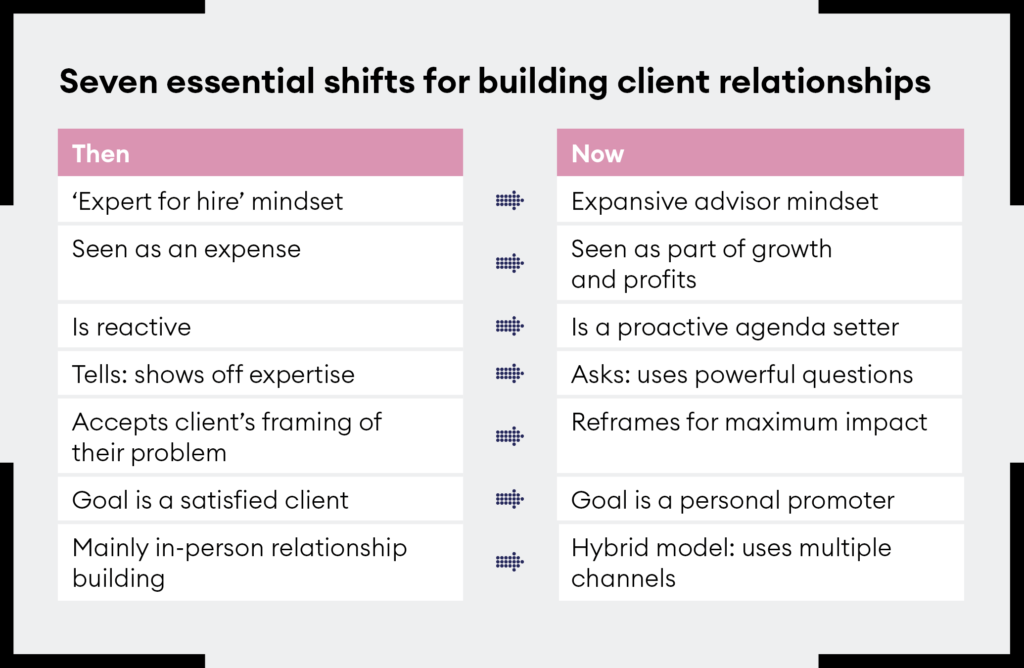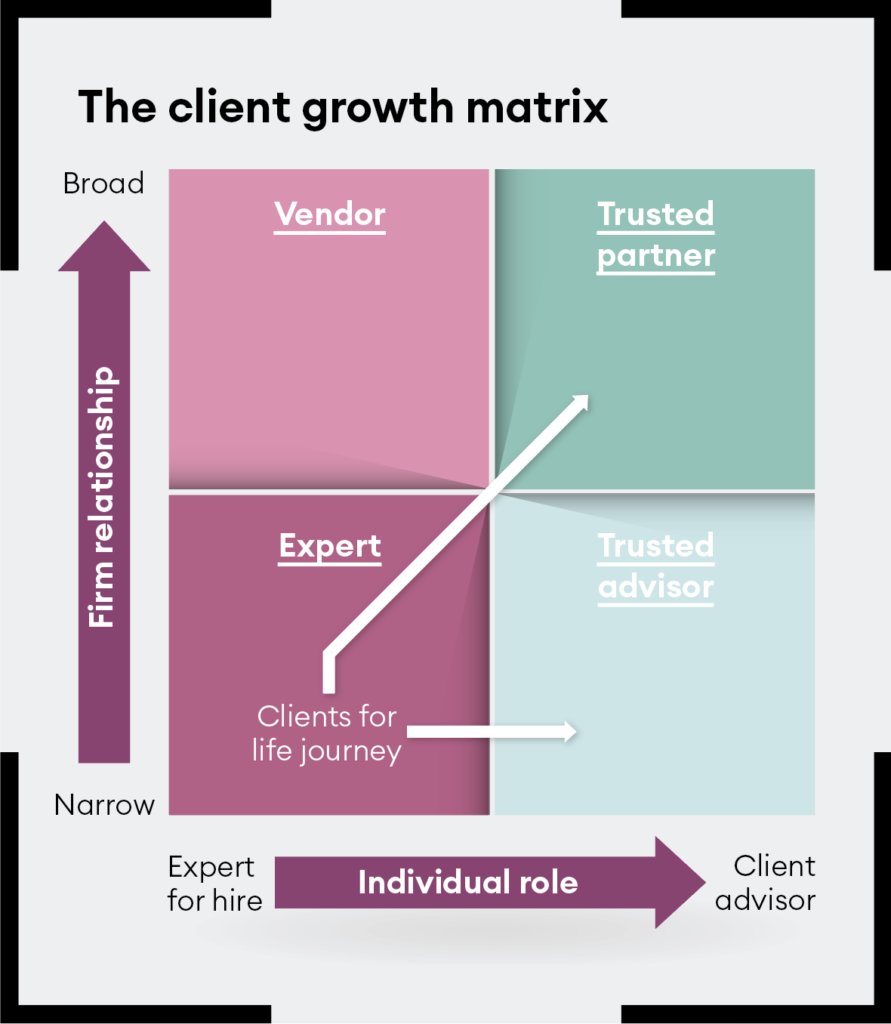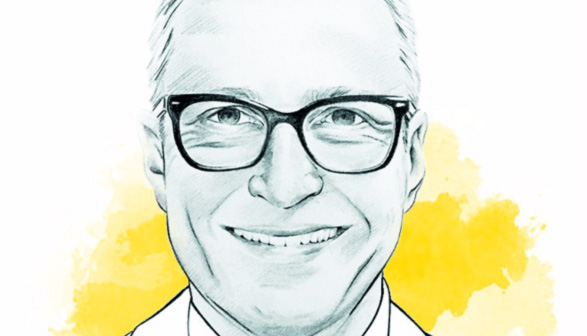A new world demands new strategies for becoming a trusted partner to your clients.
The chief executive of a successful technology company recently agreed to meet with several partners from a prestigious global consulting firm. He didn’t know them, but given the firm’s reputation, he was curious about what they might have to say.
“Three of them showed up,” the CEO told me. “They sat down and opened the meeting by saying, ‘So, tell us about your business.’ Not exactly a penetrating question,” he added.
The chief executive stood up and bluntly replied, “No. I won’t. Explain to me why you’re here, show you’ve done your homework, add some value to the conversation first, and then maybe I’ll open up about my business and my plans.”
A tactic that might have worked ten or 20 years ago fell absolutely flat.
This story illustrates one of several important shifts in the dynamics of client relationships. In the past, you had to build a relationship first – perhaps doing a lot of ‘schmoozing’ – in order to have the opportunity to then add value and sell something. Today, you must add value up front to earn the right to have a relationship. The paradigm has been turned upside-down.In order to understand how to build what I call trusted partner relationships with your clients, you must take into consideration at least four significant trends affecting how companies buy products and services in today’s B2B marketplace. First, as illustrated above, clients want more value in their relationships, and they are asking their suppliers to do more for less at every stage of the relationship. Second, in line with that, clients are pervasively using procurement and competitive bidding to try to increase their return on investment (ROI). Third, clients are consolidating their buying and want to form strategic partnerships with fewer suppliers – which, again, helps increase value and reduce risk. And finally, corporate executives realize that most of their problems do not exist in silos, and they want external providers to take an enterprise-wide view of their challenges.This also means understanding that technology must now be embedded in every single aspect of a company’s operations.
Strong client relationships are therefore harder than ever to build, but they are also more important than ever to your success. One of the keys to differentiating yourself in a hyper-competitive market is learning more about your client’s priorities, needs and goals than any other competitor – and to reach this level of understanding, you need a deep relationship.
These trends have major implications for virtually any business that sells to large organizations. If you want to build consultative relationships with senior executives and be seen as a trusted advisor (on the individual level) or trusted partner (at the institutional level), there are seven essential shifts you have to master.

1 From expert to advisor
You need to fundamentally shift your mindset: from thinking narrowly as an expert for hire, who is enamoured of their own products or services, to the more expansive advisor mindset. Expertise per se is a commodity. What separates one expert from another is, in part, their ability to put their solution in the context of the client’s business. Experts are focused on themselves and their extensive expertise. Advisors are focused on the client and developing an ever-deeper understanding of the client as a person, their organization, and their industry or sector. Experts sell what they know, whereas advisors sell what their firm knows. Experts build professional credibility, but advisors develop deep personal trust. Advisors are also experts – they have deep subject matter knowledge – but they add business acumen on top of that expertise.
2 From an expense to part of growth and profits
If clients view you as an expense, they may cut you at any time. If they view you as being an integral part of their growth and profits, however, you become an investment that they can’t get enough of. How do you do this? By showing how your solution directly supports the client’s strategic goals. You must also work at the right level. Middle managers and procurement have strict cost budgets, whereas more senior executives can create budget for a great idea that has a high ROI. They can appreciate and act on something that drives growth and profits.
3 From agenda reacting to agenda setting
Despite talk to the contrary, most professionals are highly reactive to their clients’ needs. When this happens you risk being delegated to procurement where you’ll have little opportunity to shape the scope of the problem and the solution. The best rainmakers proactively sense and anticipate their client’s agenda of critical priorities, needs, and goals. They push deeper and deeper into their client’s planning and ideation cycle, collaboratively shaping the agenda. This ‘demand generation’ strategy often results in sole-source business.
4 From telling to asking
When I ask executives about their most trusted advisors, one of the things they often mention is their use of questions. One top executive told me, “I can always tell how experienced someone is by the quality of their questions.” She didn’t say it was because they had such quick and clever answers, or great PowerPoint slides! The best questions are open-ended; surprising; they uncover root causes; they help focus the conversation (“What’s the most important issue we should be focusing on this morning?”); they engage the other person in self-assessment, and they help you get to know them as a person. Just don’t ask, “What keeps you up at night?” It’s now a cliché that has been overused by salespeople for the last 30 years. And besides, it’s a problem question, not an opportunity question.
5 From framing to reframing
Clients often describe or ‘frame’ their problems too narrowly. Fixing a product quality problem often involves interventions back into R&D and forward into sales. Implementing a new technology may have unanticipated impacts on multiple areas of the enterprise. Clients tend to focus on the symptoms, not the root causes. When you reframe, you push back and try to define the right problem – the total problem, and the total solution. This involves assessing the implications of the issue in at least four key areas: strategy, enterprise-wide linkages, implementation, and change management. You can reframe the discussion by simply saying, “Would you mind if I ask a few questions to help me better understand the context for this programme you want to launch?”
6 From satisfied clients to personal promoters
Just because a client is ‘satisfied’ with your product or service doesn’t mean they will be loyal. You need to think in terms of providing multiple layers of value – I call them core value, surprise value, and personal value – if you want to create a loyal ‘personal promoter’. Core value is what is specified in the contract – it’s table stakes. Surprise value represents benefits the client didn’t expect but is delighted by. The chief executive of a large company, for example, told me this about a major service provider he had hired: “They executed the project very nicely. But in some ways, what I most valued was the leadership and team alignment that resulted from their work.”
Personal value is when a client feels they have personally grown and benefited from the relationship with you. Perhaps they became a better leader, made valuable network connections, developed more clarity on their career direction, or learned new skills. Research has shown that someone doesn’t really root for you until they feel a personal connection. A personal promoter will recommend you to everyone in their organization and their network, and take an interest in your success – because you helped them succeed.
7 From single- to multi-channel relationship building
Another shift, the extent of which we cannot yet be certain, is that from single- to multi-channel relationship building. In-person relationship building has been augmented for decades by phone, email, texting, video, and of course social media and LinkedIn. But the Covid-19 pandemic dramatically shifted this mix, at least for a while.
Just as retailers have had to develop so-called omnichannel marketing and sales strategies, business professionals will need to become adept at using a variety of channels to develop, grow, and sustain client relationships.
Many of my clients report that while it has in some ways become easier to engage virtually with existing clients, it’s much harder to connect with prospective clients who don’t already know and trust you. Overcoming this barrier will require stronger efforts to gain recognition for your expertise in your chosen market, which will draw new clients to you. It will also mean finding more creative ways of adding value well in advance of asking for an actual meeting.
Lastly, in a world where so much commerce takes place online and contracts can be consummated without ever having a face-to-face meeting or even a video conference, it’s easy to forget a simple truth: great relationships are based on great conversations, not one person showing the other how much they know.
For a friend of mine, a senior partner in a well-known global firm, this was a lesson that became the turning point in his career. One day, he was leaving the office of a senior executive who was his client. Poking out of the top of his briefcase was a thick PowerPoint presentation. The executive’s assistant stopped him and said, “You know, you ought to come more often – my boss enjoys talking to you.” He replied, “Well, I’m glad he feels that way. And, we do prepare carefully for these meetings,” pointing to his briefcase. At that point the assistant told him, candidly, “Listen. My boss has confided to me that he views those PowerPoint slides of yours as the price he has to pay to have a good conversation with you!”
Even in a commoditized market, you can add a huge amount of value and differentiate yourself in a conversation with your client that conveys insights about their industry and markets, puts thought-provoking questions on the table, and helps them gain new perspectives on their challenges.
You won’t succeed in today’s hypercompetitive B2B marketplace using antiquated sales techniques, dragging PowerPoint decks from meeting to meeting, or asking stale questions like “What keeps you up at night?” The bar is vastly higher than it used to be. Winning and keeping clients today requires a series of important shifts in your behaviour and tactics.





